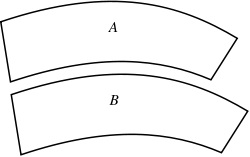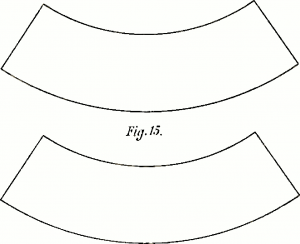Help us get to over 8,767 articles in 2025.
If you know of a magician not listed in MagicPedia, start a New Biography for them. Contact us at magicpediahelp@gmail.com
Boomerang Illusion
The Boomerang Illusion (also known as the Jastrow Illusion) is an effect based on an optical illusion in which two boomerang shapes appear to shrink and grow while in actual fact they are identical.
The optical illusion is often credited to Professor Joseph Jastrow, a pioneering psychologist who studied optical illusions at the end of the nineteenth century. The same illusion was published earlier by Felix Müller-Lyer in 1889 [1] and by Wilhelm Wundt a few years later. Psychologists often refer to it as the Jastrow-Wundt illusion of size. This optical illusion has been used by psychologists to investigate how we perceive the size of things. It has also been used to test whether people with brain damage have a full field of vision. The Jastrow Illusion has even been tested with chimpanzees to find out how our perception functions. The psychological mechanism that causes this illusion is still a matter of discussion amongst researchers.[2].
Some research on optimizing the visual effect has also been done [3] Japanese psychologist Shogu Imai experimented with different versions of the Wundt Illusion in 1960 to find out which combination of measurements creates the strongest illusion. He varied the inner and outer radius, the opening angle of the segment, and the angle of the ends. He also looked at whether the distance between the two shapes, or whether they are horizontally or vertically influences the strength of the illusion. Imai showed different versions of the illusion to a group of people and asked them to rate the perceived difference in size. Imai found that the maximum reported difference was about ten percent. He also found that the inner radius should be 60% of the outer radius to achieve the maximum effect. The ideal opening angle was found to be 80 degrees. The cut angle is most effective at zero degrees, which occurs when the line extends through the centre of the circle segments. He also found that the illusion is strongest when the segments are horizontal and that the ideal distance is just above each other. Overlapping the segments or moving them too far apart destroys the illusion.
The boomerang illusion has been performed by magicians for almost as long as it has been studied by psychologists. Over the past century, a wide variety of versions of this illusion has been published and marketed under many different names.
The oldest known reference to the Jastrow Illusion as a magic trick is from a 1913 book by Will Goldston, a popular English magician of the first half of the twentieth century. Goldston uses two boomerang shapes with boy scouts drawn on them. The trick is presented as a guessing game, proving the spectator wrong after they point out which of the boy scouts is the largest.[4]
The first widely commercially available version of this illusion uses the inherently magical boomerang to provide context to the routine. P&L marketed the Stretch-It Boomerang Sticks in 1935. These are brightly painted boomerang shapes, one of which contain a gimmick which allows it to be shortened. The original advertising by L&L and a stamp on the wooden props state that a patent for the gimmick was pending. A review of the official registers does, however, not reveal any patent issued for this trick. Irrespective of their patent claims, this original version has been copied several times. Max Andrews’ Vampire Studios in London sold the gimmicked prop as Beaumont's Boomerangs in the 1940s and 50s. The original P&L designs are currently sold by the Viking Magic Company as the Bafflin' Boomerangs and by Magic Makers under the same name.
A rare and interesting innovation to the Boomerang Illusion is the Pad-O-Rang, developed around 1955 by Hollywood magician Merv Taylor. This version adds another dimension by turning the arches into a paddle trick. It consists of two acrylic boomerangs with a small handle which can be used to demonstrate the optical illusion and combine it with the Paddle Move to show colour changes.
Scottish creative force in magic Ian Adair has developed several versions to be performed for children using fish, caterpillars and bananas. He introduced a theatrical innovation by adding a drawing on the back using both arches. In Monkey Puzzle the two bananas become the face of a monkey, in Butterfly Puzzle the caterpillars become a butterfly and in Fishy Tale two fish are eventually eaten by a cat.
George Murray and Tom Jorgenson published a sleight of hand version through Nielsen Magic in 1990. The booklet contains three small plastic boomerangs and instructions for six routines. They are marketed as colour changing boomerangs, but the routines also include the traditional size changes. The same routine was also published by Dale Price in M-U-M in 2000.
Terri Rogers, an English ventriloquist and magician, has created many routines based on geometry and has also produced an original contribution to the Boomerang Illusion. Top of the Bill is a Close-Up Illusion where the boomerangs are cut-outs from a variety poster with Stan Laurel and Oliver Hardy printed on them. Her routine involves audience participation and at the end of the proceedings, both the magician and the spectator are left with two boomerangs that are actually different in size.
Legendary Japanese magic trick manufacturer Tenyo has also innovated the Boomerang Illusion. The Sakkaku Scale, or Illusion Scale uses three boomerangs, two with kitties printed on them and the third one is a scale to measure the other two.
In 2006 Chuck Leach developed the Boomerang Cards Across. He innovated this old effect by using card fans. In this trick, the optical illusion is not the effect but is used as a method to transpose a selected card from the shortest to the longest fans. The card fans look a bit like a card fan holder that Bridge players use to keep all their cards together.
In 2023 David Regal created THE LONG AND SHORT OF IT uses this classic illusion to provide a very entertaining routine! Sold by TNT Magic [5]
Bibliography
- Bateman, L. (1949). Yo-It-Chi. Abracadabra, 8(183), 214–215.
- Brodahl, L. A. (2015). Scripted! #1: Professors Nightmare and Fiber Optics Extended.
- Carson, R. (1965). Jimmy Lake, President, Fellowship of Ministers Convention. Linking Ring, 45(2), 111.
- Dayton, R. (1994). Fish sticks. M-U-M, 83(September), 30–32.
- de Courcy, K. (1997). A brief talk on the banana. Linking Ring, 77(1), 91–93.
- Eden, B. (1977). Magic from the “Perception” Perspective. Magic Circular, 71, 63–64.
- Freer, W. (n.d.). Boomerang Fish. In Freer’s exclusive mysteries. Miracle Factory.
- Ginn, D. (2010). Baffling boomerangs. Magicana, 57, 10–13.
- Goldston, W. (1913). An Optical Illusion. In Simple Conjuring Tricks That Anyone Can Perform. London: C. Arthur Pearson.
- Gower, H. (1962). Magic mudguards. Abracadabra, 33(833), 4–6.
- Hoy, D. (1957). The Bible and magic. Linking Ring, 37(3).
- Kaufman, R. (2016). Genii Speaks. Genii, 79(2), 10–11.
- Kleefield, J. (2008). Boomerang Teach-In. Linking Ring, 88(5), 84–85.
- Pecor, C. J. (2001). The boomerangs revisited. Linking Ring, 81(5), 108–109.
- Price, D. (2000). Color changing boomerangs. M-U-M, 89(May), 36–38.
- Rogers, T. (1998). Top Secrets. Martin Breese.
- Society of Indian Magicians. (1947). Spell of India. Linking Ring, 27(10), 64–65.
- Solomon, E. (n.d.). Tales Worth Telling.
- Spragg, B. (1959). Hocus Pocus Parade. Linking Ring, 38(11), 43–46.
- Sweigard, M. (1968). The two banana illusion. Linking Ring, 48(1), 72–73.
- Thurston, Howard (1927) Which Is Larger?. In 200 More Tricks You Can Do.
- von Weber, H. (1940). Money from magic. Linking Ring, 20(4), 302–305.
- 省吾, 今井 (1960-01-01). "Jastrow 錯視に関する実験". 心理学研究. 30 (5): 350–356. doi:10.4992/jjpsy.30.350.
Notes
- ↑ Optische Urteilstäuschungen. Dubois-Reymonds Archiv für Anatomie und Physiologie, Supplement Volume, 263–270 (1889)
- ↑ Peter prevos, The Jastrow Illusion in Magic. A treatise on the Venerable Boomerang Illlusion (2016).
- ↑ Japanese psychologist Shogu Imai [1]
- ↑ "An Optical Illusion", Simple Conjuring Tricks That Anybody Can Perform by Will Goldston (1913)
- ↑ [2] THE LONG AND SHORT of IT sold by TNTMagic




